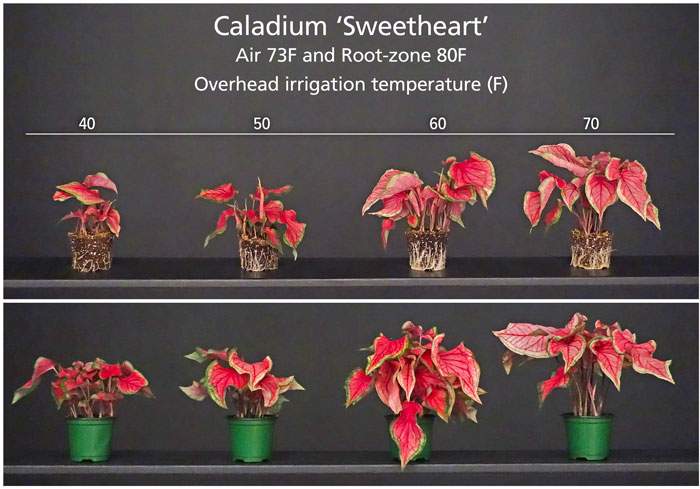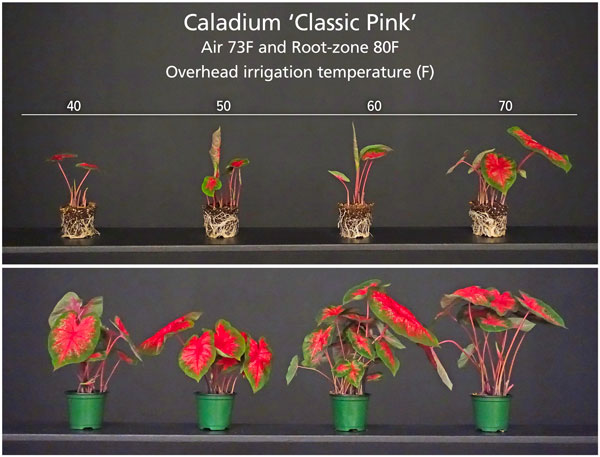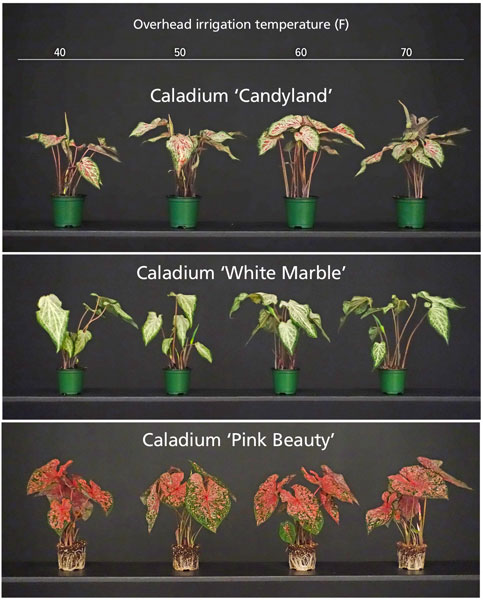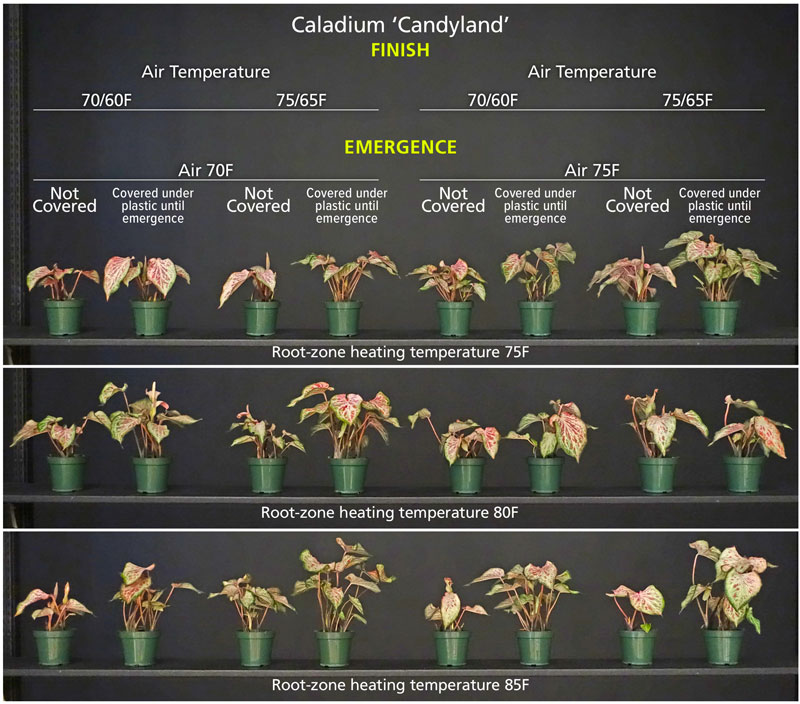11/1/2022
Avoiding Caladium Conundrums, Part 2
Roberto Lopez & Nathan Durussel

In the first article of our two-part series, we illustrated how the emergence of caladium shoots was influenced by the air and root-zone temperature and by covering the containers with plastic. In this article, we’ll look at how irrigation water temperature influences emergence and quality of some cultivars, and how day and night air temperature during forcing can be used for height control.
The study
No. 1 tubers of caladium (fancy and strap leaved) Classic Pink, White Cap, Candyland, White Marble, Miss Muffet, Pink Beauty, Sweetheart and Tapestry were received from Classic Caladiums and Bates Sons and Daughters Caladiums. The tubers were allowed to cure for seven days, de-eyed following industry protocols and planted in a 4.5-in. container filled with a peat and perlite-based substrate.
Figure 1. Potted Caladium Sweetheart tubers placed in a greenhouse with air temperatures of 73F and on a bench with a root-zone heating temperature set point of 80F. Plants were irrigated with water that was 40, 50, 60 or 70F. Photos taken after 6 weeks (top) and 9 weeks (bottom).
The potted tubers were then placed in a glass-glazed greenhouse under natural daylengths with air average daily temperature (ADT) set point of 73F (22C) and a root-zone heating (RZH) set point of 80F (26C). Plants were irrigated as needed with reverse osmosis (RO) water and fertigated weekly with RO water supplemented with 13N–3P–15K water-soluble fertilizer providing (in ppm) 125 nitrogen, 12 phosphorus, 100 potassium, 65 Ca, 12 Mg, 1.0 iron and copper, 0.5 manganese and zinc, 0.3 boron, and 0.1 molybdenum. The RO irrigation water and fertigation water was either chilled or heated to 40, 50, 60 or 70F.
 For the second study, once 50% of the plants of one cultivar and treatment (as described in the first article) had emerged, they were transferred to one of two greenhouse compartments with day and night (12h/12h) air temperature set points of 70/60F (65F ADT) and 75/65F (70F ADT) under natural daylengths for finishing.
For the second study, once 50% of the plants of one cultivar and treatment (as described in the first article) had emerged, they were transferred to one of two greenhouse compartments with day and night (12h/12h) air temperature set points of 70/60F (65F ADT) and 75/65F (70F ADT) under natural daylengths for finishing.
Figure 2. Potted Caladium Classic Pink tubers placed in a greenhouse with air temperatures of 73F and on a bench with a root-zone heating temperature set point of 80F. Plants were irrigated with water that was 40, 50, 60 or 70F. Photos taken after 6 weeks (top) and 9 weeks (bottom).
Our findings
Generally, time to emergence of Sweetheart, Classic Pink, Tapestry, White Cap and Miss Muffet was hastened, and shoot and leaf number increased when the irrigation water temperature was heated to 70F.
For example, when potted tubers of Sweetheart and Classic Pink were irrigated with water that was 40, 50, 60 or 70F, time to emergence was 29, 26, 24 and 21 days and 32, 28, 25 and 21 days, respectively (Figures 1 and 2).
More importantly, after nine weeks of irrigating plants with 40 to 70F water, the number of shoots that emerged and leaves that unfolded was negatively impacted by cold irrigation water.
For instance, Sweetheart and Classic Pink tubers produced five, eight, 10 and 11 shoots and five, seven, nine and 11 shoots, respectively, when irrigated with water that was 40, 50, 60 or 70F. Similarly, the number of medium and large Sweetheart and Classic Pink leaves that unfolded was 11, 11, 14 and 14 leaves and nine, 10, 11 and 13 leaves, respectively. For caladium cultivars White Marble, Candyland and Pink Beauty, time to emergence and quality were similar if the irrigation water temperature was ≥ 50F (Figure 3).
 Finish plant quality was influenced most by the air and root-zone temperatures provided during emergence, and both day and night finishing temperatures of 70/60 and 75/65F were effective temperatures for finishing the crop. However, we found that all caladium cultivars we tested were more compact when they were finished at 70/60F. For example, Candyland finished at 75/65F were 2 to 4 in. taller and fuller than those finished at 70/60F (Figure 4).
Finish plant quality was influenced most by the air and root-zone temperatures provided during emergence, and both day and night finishing temperatures of 70/60 and 75/65F were effective temperatures for finishing the crop. However, we found that all caladium cultivars we tested were more compact when they were finished at 70/60F. For example, Candyland finished at 75/65F were 2 to 4 in. taller and fuller than those finished at 70/60F (Figure 4).
Our research shows that irrigation water, air and root-zone temperatures and covering containers with plastic during emergence can impact the growth, development and quality of finished caladium containers. Excessively low or high temperatures can be detrimental to caladium quality. Additionally, finishing temperatures can be utilized as a PGR to build the desired plant architecture your market desires.
General recommendations for forcing of strap-leaf, fancy and dwarf caladium cultivars:
Sprouting/emergence:
Irrigation water temperature—Maintain irrigation water temperature between 60 to 70F.
Air and root-zone temperature—If you’re covering pots with plastic until emergence:
• Maintain air temperatures between 70 to 75F.
• Avoid root-zone heating temperatures >80F.
• Substrate temperatures can exceed 100F with a RZH set point of 85F and plastic.
If you’re NOT covering pots with plastic:
• Maintain your air temperature at 75F.
• Maintain your root-zone heating set point between 80 to 85F.
Finishing the Crop:
Air temperature
• Air and RZH temperature and covering practices prior to emergence will influence finish plant quality.
• If pots are covered with plastic prior to emergence, plants can be forced at 70/60F.
• To produce full and compact plants, maintain air temperatures of 70/60F during finishing.
• To produce full and taller plants, maintain air temperatures of 75/65F during finishing. GT

Figure 3. Potted Caladium Candyland, White Marble, and Pink Beauty tubers placed in a greenhouse with air temperatures of 73F and on a bench with a root-zone heating temperature set point of 80F. Plants were irrigated with water that was 40, 50, 60 or 70F.
Acknowledgements: We thank J.R. Peters for fertilizer, Classic Caladiums and Bates Sons and Daughter’s Caladiums for tubers, East Jordan Plastics for pots, Kalamazoo Specialty Plants for shipping, Hawthorn Gardening for water chillers, The Fred C. Gloeckner Foundation, the Western Michigan Greenhouse Association and the Metro Detroit Flower Growers Association for funding.
Roberto Lopez is an Associate Professor and Controlled Environment/Floriculture Extension Specialist, and Nathan Durussel is a greenhouse technician in the Department of Horticulture at Michigan State University.